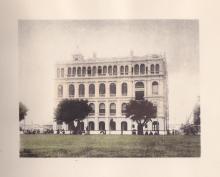Pirates operating out of Cheung Chau Or Lantau
Primary tabs
Submitted by gary john liddell on Wed, 2013-01-30 08:54
Good morning David.
There has been much written about the Taipa based pirates but I am led to believe that there may have been bases located around Hong Kong.
Can you help out.
All the best.
Gary Lixde
Forum:


Pirates
Hi Gary,
Not something I know much about, but a few ideas:
Please let us know if you find anything interesting,
Regards, David
Piracy
The Resource Centre of the Hong Kong Maritime Museum would be a good place to start www.hkmaritimemuseum.org as they publish a booklet on Piracy which was available from their shop. Alternatively, the book 'I Sailed With Chinese Pirates' by Aleko E. Lilius written in the 1920s gives a good descrition of pirate activities around Hong Kong at that time. This was available in a 1991 as a paperback published by Hong Kong Oxford University Press. The photo illustrations of life on the pirate junks and sailing junks with multiple cannons are interesting.
Pirates operating out of Cheung Chau or Lantau
Hello David & IDJ.
Thank you both for the leads.I may do some serious reading & go & have a poke around both islands when Im in HK in a couple of weeks .
Thanks again
Gary
In 1940 RASC baker
In 1940 RASC baker Staff-Sergeant Sheridan went on a two week holiday to Lanatau with his colleague S.-S. James. While there they called in at a tiny police station and met Sergeants Galvin (from Cork ) and Taylor (English):
Sgt. Galvin asked if we would like to come on a raid one night, we agreed. So instead of staying at the monastery we made our way to the Police Post before dark. We discovered that the Sgts. had no contact with their HQ in Hong Kong other than by letter. There was no radio or telephone communications. They enquired if we could handle a .38 revolver, as we both could, we were given one and 10 rounds of ammunition. The island to be raided was about 1½ hours journey by fast junk. The motor launch could not be used as it was too noisy and would alert the pirates. The Sgts. were armed with Thompson sub-machine guns, the Chinese and Indian constables had rifles and revolvers. We set off about midnight, it was a very dark night and we carried no lights. As we neared the Island all cigarettes were put out and all were warned to keep quiet. We grounded on a sandy beach in a dead calm sea. The Sgts. told James and I to stay in the boat, with two Chinese constables. All the rest went very stealthily inland. After about ½ hour we heard shouting and a lot of firing. The chatter of the Tommy guns could be heard as well as the crack of the .303 rifles. Soon we heard them crossing the beach, one of the Chinese constables called out and was answered. They had four prisoners, two were wounded and one of the Chinese constables had a hand wound. They also had a collection of weapons, Lee Enfield rifles and Germany Mauser pistols. Sgt. Galvin said four pirates had been killed but others had got away. The bodies would be collected later. The junk was now crowded, although two hurricane lamps were lit, and some first aid rendered to the wounded, they were then handcuffed. What a rough crowd of desperadoes they looked in appearance. We made slow progress back to Taio, as the wind was not favourable for a sailing junk. It was daylight when we arrived, the prisoners were locked up and would be taken to Hong Kong when the launch arrived.
Thanks Brian, that's a great
Thanks Brian, that's a great first-hand account of dealing with pirates.
I wonder what would be considered the most recent pirate incident in Hong Kong waters?
Regards, David
Pirates operating out of Cheung Chau or Lantau
Good morning Brian & David
Thanks for that report,quite a yarn.I can remember reports of pirate attacks (SCMP) in the 50s occuring around the Lei Mun entrance to the harbour.It was common to see merchant ships with anti pirate railing around the decks to prevent boarding
Aleko Lilius -- be careful
Personally I don't think Lilius was very reliable. He was convicted of fraud in Hong Kong, and also in the Philippines, but the verdict was overturned on a technicality on appeal.
I don't think Lai Choi San, the pirate queen he supposedly sailed with, actually existed. I've looked at lots of newspaper reports about pirates in the 1920s and 1930s and she is not mentioned in any from Hong Kong. It sems, the further you go from Hong Kong, the more seriously the newspapers take her existence. Also, there are no mentions I could find of her in overseas newspapers before Lilius's book was published.
Where's it from?
That's a fascinating story. What's the source?
Andrew